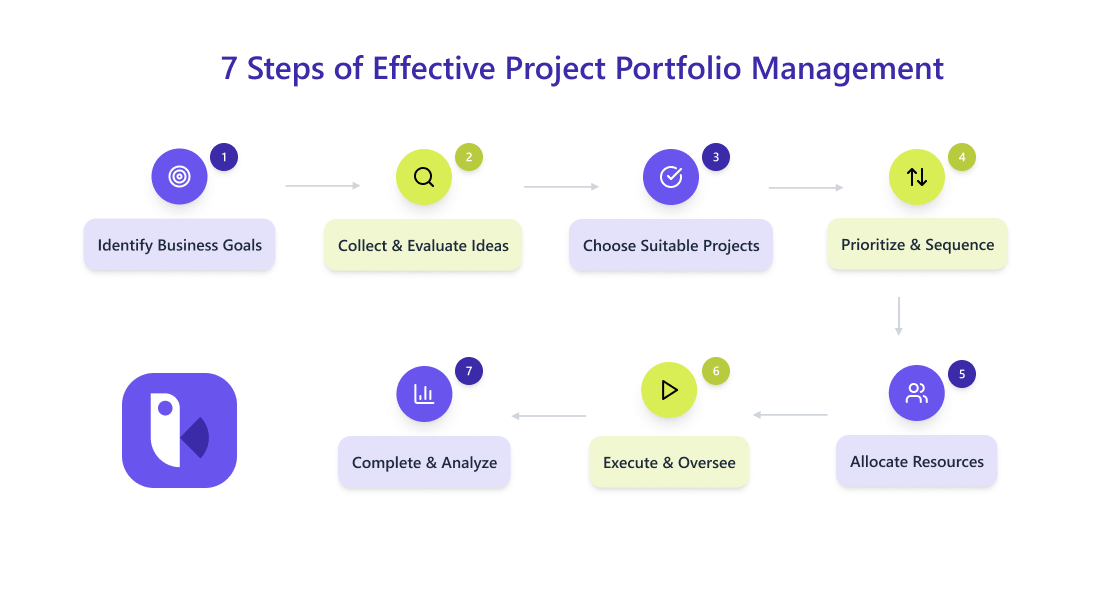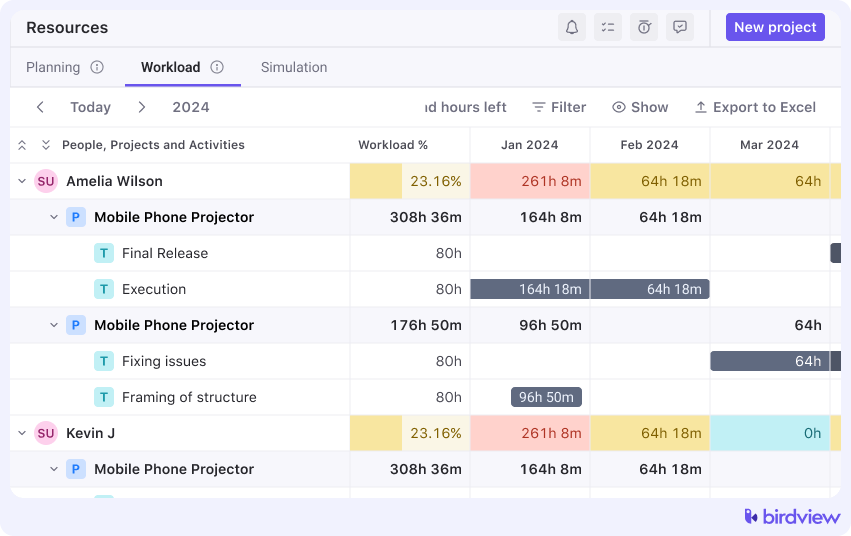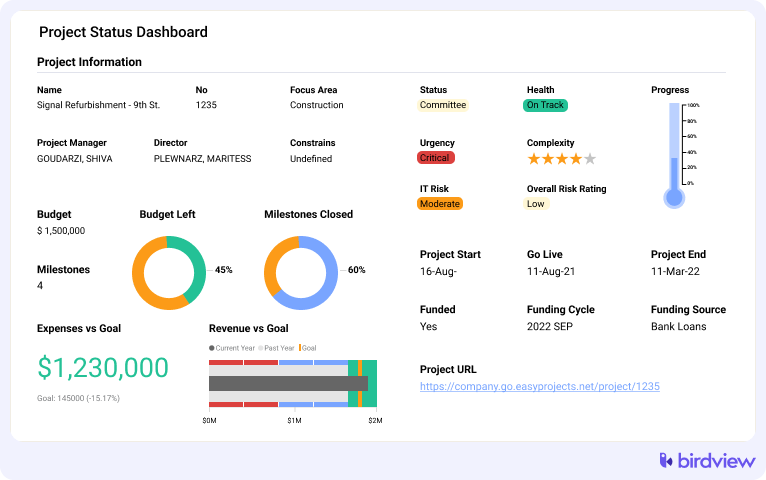Instead of managing projects in isolation, EPPM brings everything together in one coordinated system. It gives leadership the clarity to see which projects are driving value, which are draining resources, and which ones may need to be paused or re-scoped. It connects strategy to execution across departments like IT, R&D, operations, and marketing.
Before we dig deeper into the enterprise approach, let‘s quickly define the foundation.
In this article
What is a project portfolio?
A project portfolio is a group of projects managed collectively to improve planning, oversight, and resource use. Unlike individual projects that focus on specific outcomes–like launching a product or upgrading software–a portfolio gives you a broader view. It helps you balance priorities, track dependencies, and ensure all efforts support larger business goals.
Now scale that idea across an enterprise–with hundreds of projects and dozens of teams–and you get Enterprise Project Portfolio Management.
EPPM takes that portfolio approach to the next level. It helps large organizations evaluate, prioritize, and manage their entire body of work in a way that supports strategy, controls risk, and maximizes impact. Whether you‘re leading digital transformation, entering a new market, or improving internal processes, EPPM gives you the visibility and structure to guide it all with confidence.
In this guide, we‘ll break down what EPPM is, why it‘s essential, and how to know if your organization is ready for it–along with examples, tips, and practical insights for PMOs, portfolio managers, and strategy teams.
What is the purpose of enterprise project portfolio management?
Project portfolio management is about seeing the bigger picture. Instead of managing projects one by one, it helps you manage them all together, like a portfolio of investments. The goal? To make sure you‘re not just delivering projects well, but working on the right ones to begin with.
Now scale that idea to the enterprise level. You‘ve got dozens of teams, hundreds of initiatives, and limited resources. That‘s where EPPM comes in.
Enterprise project portfolio management helps you align all projects with your strategy. It gives leaders a clear view of what‘s happening, what‘s worth funding, and where to focus time, budget, and people. It helps you prioritize, plan, and pivot when needed.
Let‘s say your company is managing 50 active projects–from client work to internal upgrades. Without EPPM, decisions get noisy and disconnected. With it, you can score each project based on value, risk, and alignment, then make smart trade-offs.
The real purpose of EPPM is strategic control. It helps you:
- Choose high-impact work
- Balance workloads across teams
- Track progress at the business level
- Adjust quickly when priorities shift
Without EPPM, teams may be busy but not aligned. With it, your organization moves together, focused on the work that matters.
Why enterprise project portfolio management matters
Enterprise project portfolio management (EPPM) matters because it brings structure and clarity to large, fast-moving organizations. When a company is running dozens or even hundreds of projects, it becomes hard to see what really drives progress.
Without EPPM, teams often work in silos. Departments start their own projects. Priorities overlap. Resources get stretched. And the most important work gets delayed or lost in the noise.
EPPM helps solve that. It gives leadership a full view of every active and planned initiative. It helps align all projects with strategy and makes sure the right people and budget go to the right work.
Here‘s what EPPM helps organizations do:
- Focus on high-value work
EPPM helps evaluate each project by its business value, risk, and fit with company goals. That way, time and resources go where they matter most. - Eliminate waste
Projects that are low-impact or off-track can be paused or stopped before they drain more resources. - Improve visibility and control
Real-time tracking helps leaders stay on top of schedules, budgets, and risks across all projects in the portfolio. - Make smarter decisions
By connecting day-to-day work with long-term goals, EPPM helps everyone understand not just what is being done, but why it matters. - Stay flexible when priorities change
When something shifts, teams can reassign people, adjust budgets, and keep moving without major disruption.
EPPM turns project management into a strategic tool. It helps organizations move with purpose, stay aligned, and deliver results that support long-term success.
How companies benefit from enterprise project portfolio management
Enterprise project portfolio management (EPPM) is more than a process upgrade – it‘s a strategic shift. For organizations managing multiple initiatives across departments and regions, EPPM brings structure, visibility, and control to complex project environments. Here are five core benefits:
Strategic alignment and smarter decisions
EPPM helps organizations focus on the right work. By evaluating every project based on strategic goals, ROI, and risk, leadership can make informed choices and invest in initiatives with the highest impact.
Improved collaboration and communication
EPPM centralizes data and improves transparency. Teams across departments can access the same information, leading to better coordination, faster decisions, and fewer misunderstandings.
Reduced risk and better control
With many projects in motion, delays and overruns are common. EPPM provides real-time portfolio visibility so managers can spot issues early, investigate root causes, and act before problems escalate.
Smarter resource and cost management
EPPM enables better capacity planning. It shows who‘s overloaded or underused, helps balance team workloads, and improves budgeting accuracy using historical data and forecasting tools.
Faster delivery and higher-value portfolios
When teams have clear priorities and fewer distractions, they move faster. EPPM also helps eliminate low-value or duplicate projects, so resources go toward initiatives that truly matter.
The result: stronger portfolios, better outcomes, and greater visibility for executives into what‘s working – and why.
Read more: Top benefits of project portfolio management for service firms
7 steps of an effective enterprise project portfolio management process
Managing a project portfolio at the enterprise level takes more than coordination. It requires a clear, repeatable process to make sure every project supports business goals. Without it, time and resources can easily be wasted on low-value work.
Here are seven key steps that form the core of an effective EPPM process–from setting priorities to reviewing results. Each one helps align strategy with execution and improve decision-making across the organization.

1. Define your organization‘s strategic goals
Every successful project portfolio starts with clear business priorities. Whether your focus is growth, cost reduction, or compliance, defined goals are essential for evaluating project value.
For example, a company aiming to expand will prioritize market-entry projects, while one focused on profitability may invest in automation. This clarity guides every decision that follows, so take time to set strategic goals and turn them into measurable criteria for project selection
2. Gather and evaluate project ideas
Once your goals are set, gather project ideas from across the organization. These might be active projects, proposals, or early-stage concepts. Evaluate each one consistently, looking at feasibility, risk, cost, and strategic fit.
Use intake forms or scoring models to assess ideas objectively. The goal isn‘t to approve everything, but to understand your options and make informed decisions. Not every idea will move forward, but every idea should be reviewed fairly.
3. Select the most valuable projects
After evaluating ideas, the next step is to select the projects that offer the most value within your available budget, time, and resources.
Use clear criteria like ROI, impact, urgency, risk, and capacity to guide your choices. Many organizations rely on scoring tools to compare projects side by side. For example, if two projects promise similar results but one needs fewer resources, it may take priority. The goal is a balanced portfolio that reflects both opportunity and capacity.
4. Prioritize and sequence the work
Once projects are selected, they need to be prioritized, since not everything can start at once. Prioritization sets the order of execution, assigns teams, and guides resource allocation.
This often involves collaboration between executives, finance, and the PMO. Trade-offs are common, especially when resources are limited or projects depend on one another. A clear prioritization process keeps everyone aligned and focused on what matters most.
5. Allocate resources and optimize team capacity
Once priorities are set, it’s time to allocate resources–budget, staff, equipment, and more–so each project is properly supported.
This step is often challenging, as demand usually exceeds supply. Tools like capacity planners or PSA software, such as Birdview, help spot bottlenecks and rebalance workloads before delays happen.
For example, if your UX designers are overloaded, you might stagger start dates or outsource portions of the work. The goal is to maximize productivity while preventing burnout and bottlenecks.
6. Execute and monitor projects across the portfolio
Execution starts when projects are fully staffed and ready to go. But in EPPM, it‘s not a hands-off phase–it requires ongoing oversight.
PMOs and portfolio managers need to track progress, budgets, and timelines in real time. If one project falls behind, they must understand the impact on the rest of the portfolio and act quickly.
Strong execution means more than just hitting individual project goals. It ensures the entire portfolio stays aligned and on course.
7. Analyze outcomes and capture lessons learned
The final step is often the most overlooked. Once projects are completed, take time to review their performance. Did the project meet its original objectives? What was the return on investment? Were there risks or challenges that could have been avoided?
This kind of post-project analysis helps improve evaluation criteria, sharpen resource planning, and strengthen future project outcomes. It also builds organizational knowledge, allowing teams to learn from past successes and mistakes.
The portfolio manager or EPMO leads this step, ensuring that lessons are shared and applied to future portfolio cycles.
These seven steps form a cycle of strategic planning, focused execution, and continuous learning. Whether you’re running ten projects or a hundred, a clear EPPM process helps ensure every investment supports your goals and delivers real value.
The role of the enterprise project portfolio manager
At the heart of any successful enterprise portfolio management process is the Project Portfolio Manager–a strategic role that connects high-level business objectives with the execution of projects across the organization. Unlike project managers who focus on delivering individual initiatives, the portfolio manager ensures the entire portfolio is aligned, balanced, and delivering value.
Here are the core responsibilities that define this critical role:
- Project evaluation and prioritization
The portfolio manager assesses all incoming and active projects based on value, strategic alignment, feasibility, and risk. This evaluation determines which initiatives are prioritized, delayed, or declined altogether. - Resource allocation
They oversee the distribution of budgets, personnel, tools, and other assets across projects. Balancing team workloads and optimizing resource usage is key to keeping the portfolio efficient and sustainable. - Portfolio-wide risk management
Beyond managing individual project risks, the portfolio manager identifies risks that could affect multiple initiatives–such as shared resource bottlenecks, cross-project dependencies, or external disruptions–and takes preemptive action. - Informed decision-making
Whether it‘s greenlighting new projects, pausing underperforming ones, or retiring outdated initiatives, the portfolio manager makes strategic decisions that align execution with enterprise priorities. - Progress monitoring and performance tracking
They continuously monitor project status, budget usage, timelines, and strategic impact. Real-time visibility enables quick course corrections and ensures projects stay on track. - Stakeholder communication and transparency
A big part of the role is keeping executives, sponsors, and department leads informed. The portfolio manager shares updates, escalates concerns, and ensures clarity behind all portfolio-related decisions. - Capturing lessons learned
After project completion, the portfolio manager analyzes outcomes and gathers insights. These lessons are fed back into the portfolio planning process to improve future performance and avoid repeating past mistakes.
In short, the enterprise project portfolio manager is both a strategist and an integrator, making sure that the right projects are selected, well-supported, and contributing to the company‘s long-term goals.
What tools are needed for enterprise project portfolio management?
Managing an enterprise portfolio isn‘t just about tracking tasks. It‘s about turning strategy into action. To do it well, you need tools that provide visibility, control, and flexibility across all your projects and teams.
Here are the essential categories of EPPM tools:
- Strategic planning tools
Help you evaluate which projects align with your business goals. They support better decisions and reduce the risk of taking on too much or the wrong work. - Resource management tools
Show you who‘s available, who‘s overloaded, and how best to allocate people across projects. This helps avoid burnout and underutilization. - Real-time tracking and dashboards
Let you monitor progress, timelines, and budgets as things happen. You can quickly spot risks and adjust plans before small issues grow. - Collaboration and communication tools
Keep everyone on the same page–from project teams to executives. Shared access to updates and data improves speed, clarity, and accountability.
That‘s why many organizations use enterprise project management software like Birdview PSA, which combines these features in one place. With the right tools, you can stop reacting to problems and start managing for outcomes. Instead of juggling disconnected systems, you keep your portfolio aligned, efficient, and focused on delivering real value.
What to look for in EPPM software?
Choosing the right enterprise project portfolio management (EPPM) software isn‘t just about finding a tool to manage tasks and timelines–it‘s about enabling smarter decisions, better resource use, and full visibility across your entire portfolio. The ideal platform should help you translate strategy into execution while staying flexible enough to grow with your organization.
Below are seven essential features to look for when evaluating EPPM solutions, along with practical tips to get the most from each one
1. Portfolio-level visibility
A great EPPM platform gives you a centralized view of all active, planned, and completed projects. This visibility allows executives and PMOs to monitor how individual initiatives contribute to broader business goals. It also helps you spot risk areas, monitor budgets, and understand performance at both the project and portfolio level–all in real time.
💡 Useful tip: Use real-time dashboards and portfolio views to track budget, timelines, and resource status at a glance. This enables proactive management, not reactive reporting..
2. Smart resource planning
Managing enterprise resources across dozens of projects is a constant balancing act. Your EPPM software should allow you to assign and reassign people based on skills, availability, and current workload. It should also make it easy to prevent overbooking, burnout, or idle capacity.
💡 Useful tip: Use visual heatmaps and resource loading reports to identify capacity gaps and redistribute assignments before issues escalate.

3. Scenario planning and forecasting
Things change quickly in enterprise environments. A strong EPPM tool lets you simulate different scenarios–what happens if a high-priority project is delayed, paused, or replaced? With forecasting capabilities, you can understand how these changes affect capacity, timelines, and delivery outcomes before making major decisions.
💡 Useful tip: Look for built-in scenario planning features that help you model different outcomes and make confident choices before committing resources.
4. Integrated time and cost tracking
To manage portfolio profitability, you need accurate tracking of hours, expenses, and budgets. EPPM software should include native time tracking and financial monitoring features that help you understand real project costs, not just estimates.
💡 Useful tip: Use integrated time logs and budget reports to track actual vs. planned spending and gain insight into ROI across your portfolio.
5. Customizable dashboards and reports
Different stakeholders need different information. Executives may want a high-level summary of strategic progress, while portfolio managers may need detailed reports on risk and utilization. Your EPPM platform should allow dashboards and reports to be customized by role, team, or department.
💡 Useful tip: Tailor dashboards for each stakeholder group–this improves clarity, reduces noise, and helps everyone focus on what matters most.

6. Collaboration and communication features
In large organizations, collaboration tools are essential to keep projects moving. Your EPPM software should support shared views, real-time updates, notifications, and centralized documentation so teams can stay aligned, regardless of where they sit.
💡 Useful tip: Encourage in-app collaboration with shared calendars, comment threads, and document repositories to reduce email overload and improve traceability.
7. Scalability and integration
Your tool should grow with your business. Whether you‘re adding more users, departments, or types of projects, the platform should remain fast and manageable. It should also integrate seamlessly with your existing ecosystem–CRM, accounting, HR, or BI tools–so you‘re not constantly jumping between systems.
💡 Useful tip: Choose EPPM software that integrates with tools like QuickBooks, Salesforce, Microsoft Teams, and other core platforms to create a unified, connected workspace.
The right EPPM software isn‘t just a system–it‘s a strategic enabler. It brings your people, data, and priorities together into one connected platform so you can lead with confidence, adapt with agility, and deliver value at scale. Whether you choose Birdview PSA or another platform, make sure it supports not just project delivery, but enterprise-wide performance.
What challenges do companies face when implementing EPPM?
Implementing Enterprise Project Portfolio Management (EPPM) can bring big value–but also real challenges. Here are the most common ones:
- Lack of strategic clarity
Without clear business goals, it‘s hard to prioritize projects or measure success. EPPM needs direction to work. - 2. Siloed teams and poor visibility
Different departments using different tools leads to blind spots. You need one view of all work across the business. - Resistance to change
New processes and oversight can feel disruptive. Teams may push back without strong communication and leadership buy-in. - Inconsistent data
If project data isn‘t accurate or up to date, decisions will suffer. Reliable reporting is essential. - No resource visibility
EPPM depends on knowing who‘s available and when. Without that, you can‘t plan effectively or avoid overload. - The wrong tools (or unused ones)
Basic spreadsheets won‘t scale. And even the best software won‘t help if people don‘t use it properly.
To succeed, companies need clear goals, executive support, and the right tools with strong adoption. Start small, stay focused, and build momentum.
How Birdview PSA supports enterprise portfolio management
Birdview PSA is built for enterprises managing large and complex portfolios. It provides visibility, alignment, and control across all projects and resources in one unified system.
It helps PMOs and portfolio managers turn strategy into action, combining planning, prioritization, and execution in a centralized workspace. With real-time dashboards, you can instantly see which projects are on track, which need attention, and how each one supports strategic goals.
Resource planning is smarter and more efficient. Birdview lets you assign people based on real capacity and skills, preventing burnout and improving team performance.
You can also run what-if scenarios to evaluate different options before committing. This means better forecasting, smoother project adjustments, and stronger business outcomes.
Birdview includes time tracking, budgeting, and ROI monitoring, so you always know how your projects are performing financially. Custom dashboards and automated reports keep both executives and delivery teams aligned without manual updates.
For organizations ready to scale, Birdview PSA offers a flexible, intuitive platform that connects strategy, people, and performance–helping you deliver real results across the entire portfolio.
Contact us to see how Birdview PSA brings clarity and control to your entire enterprise project portfolio.

Implement enterprise project management (step-by-step) →
4 Essential Steps of Project Portfolio Optimization →
Best Project Portfolio Management Software 2025 →
Best Enterprise Project Management Software 2025 →
![❓]() Enterprise project portfolio management: FAQ
Enterprise project portfolio management: FAQ
1. What is the difference between project management and enterprise portfolio management?
Project management focuses on delivering individual projects on time and on budget. Enterprise project portfolio management (EPPM), on the other hand, takes a broader view. It‘s about managing all projects in a coordinated way that supports strategic goals, balances resources, and maximizes business value.
2. Who should be responsible for EPPM in an organization?
Typically, the PMO (Project Management Office) or a dedicated Portfolio Manager owns EPPM. In large enterprises, it‘s a strategic role that sits between executive leadership and project delivery teams, ensuring alignment, oversight, and decision-making support.
3. When should a business adopt enterprise project portfolio management?
EPPM becomes essential when:
-
You manage dozens of projects across departments.
-
You struggle to prioritize or fund the right work.
-
Resources are stretched or misaligned.
-
Strategic goals are unclear at the project level.
If you‘ve outgrown simple project tracking tools and need to link execution to strategy, it‘s time to consider EPPM.
4. How is EPPM different from standard portfolio management?
EPPM operates at enterprise scale–covering all departments, central oversight by EPMO, cross-portfolio resource pooling, and full alignment with corporate strategy. Standard PPM often sits within a single department.
5. How is EPPM different from traditional portfolio management?
Traditional portfolio management often lives within one department or function (like IT). EPPM is enterprise-wide–it covers all initiatives across business units, aligns them with corporate strategy, and allows for cross-functional resource sharing, risk management, and performance analysis.
6. Do I need special software for enterprise portfolio management?
Yes. Excel and task-based tools don‘t scale well for enterprise needs. You need a purpose-built EPPM or PSA platform like Birdview PSA, which combines strategic planning, resource management, budgeting, collaboration, and reporting in one place.
7. How do you measure the success of EPPM?
Common EPPM success metrics include:
-
Portfolio ROI and profit margin
-
Resource utilization rates
-
Project alignment with strategic objectives
-
Number of completed high-priority projects
-
Time to value or delivery speed across the portfolio
8. Is EPPM only for large enterprises?
While EPPM is most common in larger organizations, growing mid-sized companies can also benefit–especially if they manage complex initiatives across departments, geographies, or client accounts.
9. What‘s the role of AI and automation in EPPM?
Modern EPPM tools often include AI-driven forecasting, automated alerts, and predictive resource planning. These features reduce manual effort and improve decision speed, especially in complex or fast-moving environments.
10. Can EPPM be used for internal and client-facing projects?
Yes. EPPM is ideal for balancing both internal initiatives (like system upgrades or process improvement) and external client work. It helps teams understand where to invest effort, what brings the most value, and how to avoid overload.

 Enterprise project portfolio management: FAQ
Enterprise project portfolio management: FAQ

